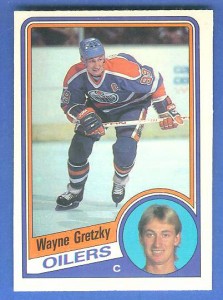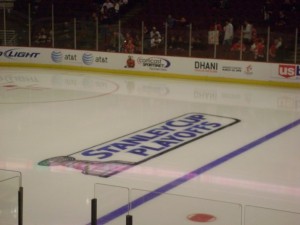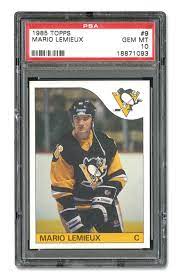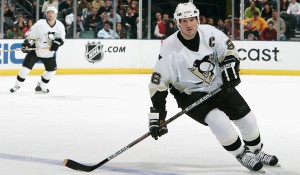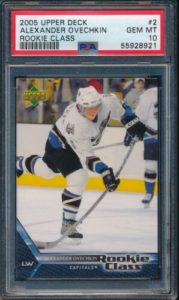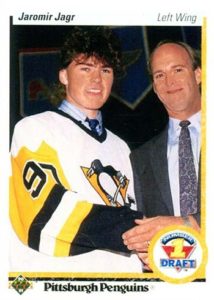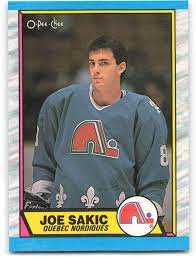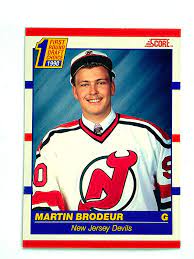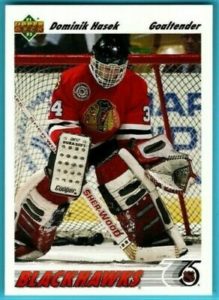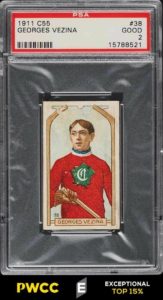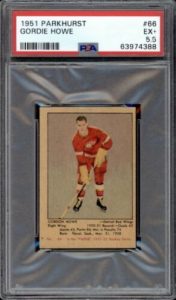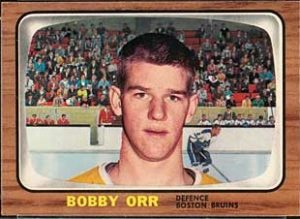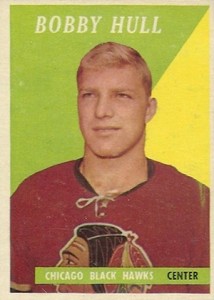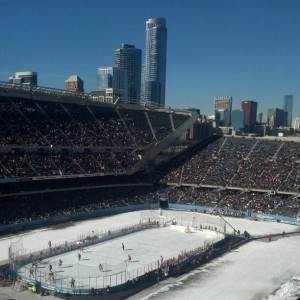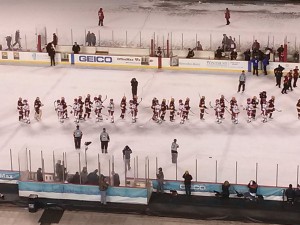Happy Stanley Cup Final! As it’s the final battle of the season, for Lord Stanley’s Cup, it’s the perfect time to really talk some hockey. As such we’ve now compiled a list of the hockey cards that we feel have the best potential future Return on Investment (ROI) over the next 10 to 20 years.
These cards aren’t listed in any specific order, exactly, but we tried to a semi-deep dive on all of them. To vivisect this topic, we enlisted the help of two sports trading card gurus:
-Jeremy Ross is a former television news man, long time card collector/seller (30 years) and industry advocate. You can find him tweeting about #TheHobby, really cute dogs and other oddities that he purveys @JeremyAdamRoss.
-Sal J. Barry, the Editor of PuckJunk.com and a writer for The Hockey News. Puck Junk is a website about hockey cards, collectibles, and culture.
- 1979-80 O-Pee-Chee Wayne Gretzky #18 RC (Sister card ’79-’80 Topps Wayne Gretzky RC #18 RC)
In breaking down the best hockey card investments, you’ve got to start with the G.O.A.T. (greatest of all-time) and that’s obviously Gretzky. Naturally, you begin the list with his most notable card. You know what they say, lead with strength, put your best foot forward.
“Obviously it’s the ‘79-80 OPC first, then the Topps rookie follows,” Norton said when we asked him about cards of The Great One.
“Everything after that is a great addition to a Gretzky collection. With that in mind, while not expensive by any means, the 88-89 OPC #120 is the first card to feature Wayne in a King’s uniform. It’s not a ‘grail’ but a fun one for fans. Also, Gretzky has very few autographs in a Blues or Rangers sweater. Those are always fun as well.”
The OPC Gretzky rookie will cost you well over a grand, even in fair to okay condition. (Think PSA or BGC 3-6ish range). A top-level, near-mint, high-graded version of this card will command $2-$4,000 on the open market. You can get the Topps version for less, but you still should expect at least four figures for a nicely graded one.
As Norton points out, finding this card in a top-tier grade can be very difficult, and thus, there is a ton of variability in pricing.
“Both the ’79-80 OPC and Topps cards are extremely conditioned sensitive and they were cut with a wire,” he said.
“That means there are plenty of centering and edge issues to be found. This card almost has to be taken on a case-by-case basis. The pricing that you see reported in Beckett can be considered a general guideline. Any given raw example may be more or less depending on how it presents. Grading is key with this card.”
You can make an argument that this card might be to hockey what the ’86-’87 Fleer Michael Jordan is to basketball and ’89 Upper Deck Ken Griffey Jr. is to baseball.
How to Spot a Counterfeit Gretzky Card Rookie Card
Kent Garnett is the owner of Pennant Fever, a cards and collectibles business. He recalls his personal experience with a counterfeit Gretzky RC:
“I said this is the deal. You’re calling me a crook for selling you a counterfeit card. I have the right to know who told you this before I give you a refund. So I made him take me in the other room. And he showed me the guy, and this guy had two stacks of PSA graded Gretzky O-Pee-Chee rookies, they were all counterfeit.
“Mine was real, but I had been coached on my trip to Canada to know the difference between a real one and a counterfeit one, and the real one, for whatever reason when they had the sheets, a spot got on Gretzky’s shoulder, so every real O-Pee-Chee rookie, there’s a little white spot on what would be his right shoulder pad.
“It’s an orange area so it sticks out very significantly and if you see one that doesn’t have that, it’s counterfeit right off the bat. Every one of them that was made that’s legit has that little white spot on the orange part of the solar pack and a lot of people didn’t know this.”
You’ve been warned, so be on the lookout.
2. 1985-86 Mario Lemieux O-Pee-Chee RC #9
After Gretzky, the runner-up hockey G.O.A.T. is Super Mario. The Magnificent One joins Gretzky in occupying all of the top ten places for points and assists in a NHL season. Lemieux, who rewrote the Pittsburgh Penguins scoring record book, might arguably be the best power play player in hockey history as well.
He’s also a cancer survivor. In 1993, the same year he was diagnosed with Hodgkin’s lymphoma (or Hodgkin’s disease), Lemieux created the Mario Lemieux Foundation to fund medical research. In 2007, he was among the founders of Athletes for Hope, an organization which helps professional athletes get involved in charitable causes. Lemieux won the Hart Trophy (MVP) and scoring title in 1995–96 after having sat out the entire previous season due to cancer treatment and rehabilitation.
In terms of Lemieux cards, you got to start with this beauty, although you can find earlier cards at a similar price or cheaper. In the hobby, 1985 is considered the consensus for the Lemieux RC, but you might want to Google the 1983 Canada Juniors set, and enjoy the glorious mullets on display. It’s like a music video for a Journey song, where you can see Lemieux rocking, as Ross called it, a Scott Baio haircut.
“When Lemieux came out, Topps, and O-Pee-Chee in this particular case, knew that he would be a big deal,” said Ross, a former reporter with WBBM-TV, CBS 2 Chicago.
“There actually are cards of Lemieux before he got into the NHL that probably also worthy of investors taking a look at, but in ’85, O-Pee-Chee, on the bottom of their boxes, printed out a series of four cards.”
You all remember those- cards printed on the very bottom of the box, and you would have to cut them out? Ross continued on about the 1985 O-Pee-Chee Mario Lemieux box bottom:
“There are some nimrods on eBay who are trying to unload those for just shy of a quarter million.”
Obviously, these were a total nightmare when it came to condition, Ross touched upon that as well.
“As you and I remember, the most grime, dirt, and scuffing is going to occur on the bottom of that box. So finding a really high quality one is next to impossible,” he said.
3. 2005-06 Alexander Ovechkin Upper Deck Young Guns RC #443
If Lemieux isn’t the greatest power play scorer in hockey history, then Alexander the Great is. He’s actually the NHL record holder for career PP goals. Drafted #1 overall, exactly 20 years after Super Mario was picked first overall, Alex O. won the Maurice “Rocket” Richard Trophy, awarded annually to the NHL’s leading goal scorer, a record nine times. In NHL history, only Gretzky and Gordie Howe have scored more career goals than this legend among legends.
This particular issue is rather legendary as well. There are just over a 1,000 PSA grade 10s of this card in confirmed existence, with the most recent sale topping $7,600. If you can snap one of these beauties up, then you might see it appreciate to a level of five figures. There really is no reason for this card not to go up, as Ovechkin is considered by many to be the greatest Russian-born player in history, and Russia, as you know, is certainly one hockey mad country.
4. 1990-91 Jaromir Jagr Upper Deck RC #356
If Lemieux is the greatest of all-time runner-up to Gretzky, then Jaromir Jagr is the second place G.O.A.T. Penguin to Lemieux. You won’t find, historically, many one-two punches in a front line as formidable as this pairing. They teamed up to form a mini-dynasty of sorts in the Steel City.
“Maybe investing in Jagr probably isn’t a terrible idea,” Ross said.
“Just because of his longevity, what he’s meant to the Pittsburgh Penguins, the number of championship seasons he was involved in. I think that he’s on that list of really impressive talent and Hall of Famers. So he might not be a bad guy to consider.”
If you are considering investing in the NHL’s fourth all-time leading scorer, then this is the card to seek out. It shows Jagr shaking hands with a Penguins front office man after being drafted by the Penguins. If you came of age in the 1990s and were into the hobby, then you must have this card etched into your memory. Perhaps as much as you recall the Pavel Bure Upper Deck card where he’s sitting near the beach and wearing Rollerblades.
One thing about the junk wax era, and people often overlook this, it brought sports card collecting mainstream. Both hockey and the hobby surged in popularity during the early ’90s and while the boom obviously went bust quite quickly, you can’t take away that the tent got much bigger and many of those people ended up staying. Jagr was coming of age back then, as the Penguins enjoyed their golden era.
5. 1989-90 Joe Sakic O-Pee-Chee Hockey RC #113
Sakic, or “Burnaby Joe,” played his entire 21-year NHL career with the Quebec Nordiques/Colorado Avalanche, where he was regarded as one of the greatest team leaders in NHL history. In his 20-year career with the Nordiques and Avalanche, Sakic obtained all the important franchise scoring records, including goals (625), assists (1,016) and points (1,641). He also holds the franchise record for most games played (1,363), as well as NHL records for most All-Star game assists (16) and playoff overtime goals (8).
He’s also a stand-up guy, as his charity work is estimated to have provided more than seven million meals to poor children and families; earning him a NHL Foundation Player Award in 2007. This is his signature issue and it’s produced by O-Pee-Chee Company, Ltd., a Canadian confectionery founded in 1911. Based in London, Ontario, O-Pee-Chee produced candy until the mid-1990s. They produced they first trading card sets in the 1930s, covering baseball, football and hockey cards until the company was sold to Nestlé in 1996.
The O-Pee-Chee brand came back, via Topps, in 1997, as they licensed hockey cards under that name until 2004. Three years later, the Upper Deck company took over the licensing and they have been releasing card sets under the O-Pee-Chee brand, up to the present.
You can get a top tier PSA graded version of this card for under a thousand bucks, and that may sound kind of affordable, relatively speaking. Why? Well, it’s from the junk wax era, which we’ll cover (as well as a player whose RC is severely undervalued simply because it’s from that period of collecting) in the very next item.
6. 1990-91 Martin Brodeur Score (Canadian version) RC #439
Brodeur is the goaltending G.O.A.T. and this is his primary RC, but you can still get it for less than $250. That’s simply unreal. Out of the four major professional sports leagues in the United States (NHL, MLB, NBA, NFL), you can’t name a player who is considered the all-time best at his position, yet has a rookie card that’s valued less than five digits.
The primary reason that Brodeur cards aren’t worth more (yes, even this one) is because the legendary shot-stopper came of age during what is known in the hobby as the “junk wax” era. In the late 1980s to mid-1990s, the market was flooded by way too many companies issuing way too many cards. In the early 1990s, demand was never going to be able to match supply.
As Barry points out, ’90-’91 was considered the beginning of the junk wax era for hockey “because you went from two companies making cards, to five, in one year.”
“Plus, hockey got more popular, due to a couple of things- Wayne Gretzky gets traded to the Kings, and that increased the popularity of hockey in America, and then Topps had an exclusive with the NHLPA that expired in 1990, O-Pee-Chee had a sub-license,” he continued.
“All of a sudden, people were able to get hockey cards anywhere, grocery stores, gas stations, convenience stores. From 1989 over to 1991, they were mass-produced.
In the truest sense, the 1990 Score issue is the only one that is his rookie card, and it comes in two different versions. The Canadian issue is bilingual, providing text in both English and French, Canada’s two official languages.
The card itself has an exciting and clever design, as it evokes a hockey rink, with the central line, blue lines, and all. While it’s an attractive card, it suffers from being produced on inferior stock, and it is thus very susceptible to easily being damaged and then downgraded in condition.
However, Barry had Brodeur rookie cards tagged at $5 when he set up shop at The National a few weeks ago and STILL nobody bought any. He also had the ’90-’91 Score factory set at his table for $10, and NOBODY bought those either.
“But if I had a card with a piece of a jersey, for $30, people bought it,” Barry told me by telephone.
“Anything high-end with Brodeur sold, but his rookie card didn’t sell. The only way to invest in him is to buy his rookie card, get it graded a PSA 10, and then try to sell it, but come on, how do you make money that way?
“Especially with PSA doubling its prices.”
7. 1991-92 Dominik Hasek Upper Deck (French version) RC #335
It’s amazing that the Chicago Blackhawks never won a single Stanley Cup, and only reached the Final once, during the 1990s when you consider who their goal-tenders were. Dominik Hasek, “The Dominator” won six Vezina Trophies from 1993-2001, the most of anyone under the award’s current system of voting. In 1998 he won his second consecutive Hart Memorial Trophy (MVP), becoming the first goaltender to win the award multiple times.
He was overlooked in favor of Ed Belfour, a first ballot Hall of Famer who is one of only two players to have won an NCAA championship, Olympic Gold medal, and Stanley Cup, doing so with Dallas. The only other such player is Neal Broten. They also had Ray LeBlanc, the USA 1992 Winter Olympic hero who went 5–2–1 with two shutouts, and nearly carried the Stars and Stripes to medaling in Albertville.
Of that legendary NHL position group it’s really only Hasek who holds a special place in the hobby, with this issue that features Hasek in his timeless red Blackhawks sweater. If you want to invest in this card, make sure it’s graded, because an ungraded card isn’t worth a ton, due to its being overproduced. Given its status as a product of the junk wax era, it is kind of like that Jagr RC that we listed and described earlier.
8. 1911-12 C55 Imperial Tobacco Georges Vezina RC #38
This is definitely it, “the Honus Wagner card of hockey,” as Ross put it. You may not know who Vezina is, who he played for and when he played, but you do probably know that he’s the godfather of goaltending.
“It never a bad thing to have a trophy named after you,” Ross added. “I’ll have to look it up to see if Lady Byng has a rookie card too.”
As you can imagine, a card this old and this scarce is pretty hard to find in top condition, and a PSA 6 might cost you half-a-million. A PSA 8 might set you back three-quarters of a million dollars, because hey, inflation in this country is now at its highest levels in a half-century. This affects everyone, including collectors of hockey cards that occupy a very elite, rarified air. No other hockey card comes even remotely close to reaching this one in valuation.
Like the Honus Wagner T206, this is a very rare card produced by a Tobacco company, and honestly, it bears some physical similarities to that card, which was once famously bought and sold by Gretzky. One thing it does have on Wagner, it’s actually a much better looking card.
9. 1951-52 Gordie Howe Parkhurst RC #66
“When you write the book on the great players for the original six teams in hockey, which of course being New York, Boston, Toronto, Montreal, Detroit, and Chicago, the storied history of the original six, to be a top player for any of those teams gives you an amazing credit,” said Ross.
“It’s like being one of the elites who played for the New York Yankees, or one of the elites who played for the Boston Red Sox, just something about elevating you to a next level.”
Howe is absolutely that, as upon his retirement his 801 goals, 1049 assists, and 1850 total points were all NHL records. These records stood all the way until the great one, Gretzky, came along. Howe still holds the NHL record for seasons played, and his all-time NHL games played record of 1,767 was only surpassed in 2021 by Patrick Marleau.
You have to put him on hockey Mt. Rushmore. He even has a Simpsons reference to his credit. Bart Simpson used a picture of him when he created a fake character to seduce his teacher, Edna Krabappel, and ultimately prank her.
So in other words, he’s a rock solid investment, and this is THE CARD for Howe. It’s his earliest card, and when you find one that is in great condition, which is rare, it’s his most valuable. Parkhurst struggled with attention to detail, in regards to quality control, and this card is often rather condition sensitive.
10. 1966-67 Topps Bobby Orr RC #35
Ross describes this as “another seminal card,” because Orr “was a player who changed the game. Most people will say that previous to him we didn’t really have offensive defenseman. He was the guy who could do it both ways.”
One of the most accomplished Boston Bruins of all-time, Orr remains the only defenseman to have won the league scoring title, and he did it twice. He also holds the record for most points and assists in a single season by a defenseman. Additionally, Orr won a record eight consecutive Norris Trophies as the NHL’s best defenseman and three consecutive Hart Trophies as the league’s MVP.
“And a nice one of his rookie cards, is the TV set that Topps made. There’s actually two versions- one that was printed in Canada, which is the most common, and there’s another printed in the United States as a test market initiative. And the United States version is far more difficult, and far more of an investment piece. It’s very rare that I see the United States printing Bobby Orr rookie card, but they exist.
“And they are pretty fantastic. According to PSA, there is a total of 890 cards of the Canadian printed for the non-USA version. And for the Topps USA test sets, there are 86. So for every one of these test set Bobby Orr rookie cards, you can find 10 of the traditional Canadian printed version. So it’s like, to use an analogy, not just a fantastic violin, it’s like a Stradivarius.”
In addition to being extremely aesthetically pleasing, these cards are very costly too. Fair grade versions of these cards go for 10s of thousands of dollars. When you get to PSA 8s or 9s versions of this card, you might be looking at paying close to five figures. Well worth it to the serious collector.
Also Worth Mentioning
Bobby Hull is one of the game’s all-time greatest players, but he’s very far from being one of the world’s nicest people. Outside the scope of this article, but you can research what has happened in his personal life, what his family has claimed he did to them, and well, it’s a very difficult read. With that in mind, his legacy won’t be as stellar as that of other hockey greats, whose cards might make a safer investment.
“Bobby Hull is always going to be one of those players (among the most elite players for the storied Original Six franchises/greatest American players of all-time), but then his rookie card, you can get a nice one for about five grand,” said Ross.
“And there’s probably a reason for that. He has the extracurricular stuff that people are aware of. But I would argue Mickey Mantle has some extra curricular stuff that you wrote about as well. So, you know, every athlete has some dirty laundry.”
If you still want to invest in The Golden Jet, then the 1958/59 Topps Bobby Hull #66 RC is the way to go. However, you might want to look at getting a Maurice “the Rocket” Richard RC instead, and with that in mind the issue most sought after is the ’51-’52 Parkhurst #4.
What about current players? Who might be the best to invest in among contemporary hockey superstars?
“Gretzky holds a place in hockey collecting that will likely never be touched by other modern players,” said Norton.
“Connor McDavid may get there, but he is the only current player that we can say that about.”
McDavid might be the way to go, as he’s accomplished a lot in such a short time. He came in to the league in 2016, and he’s since made five All-Star appearances, won two MVP awards and led the league in scoring three times. So with that in mind, the Connor McDavid card you want is the 2015 Upper Deck Young Guns #201 RC.
However, you have to remember that hockey card investing can be a double edged sword. Hockey cards didn’t surge as much as the other sports during the most recent boom, so they still have plenty of room to grow in value. The question is will they appreciate, exponentially, in value like the other sports did?
“Hockey cards are way undervalued when compared to cards from other sports,” said Barry.
“Then again, as a hockey collector, I don’t mind that the prices of the cards I like to collect tend to be lower than they are in other sports.”
Food for thought, for all hockey hobbyists and those considering entering the space.
Paul M. Banks is the owner/manager of The Sports Bank. He’s also the author of “Transatlantic Passage: How the English Premier League Redefined Soccer in America,” and “No, I Can’t Get You Free Tickets: Lessons Learned From a Life in the Sports Media Industry.”
He’s written for numerous publications, including the New York Daily News, Sports Illustrated and the Chicago Tribune. He regularly appears on NTD News and WGN News Now. Follow the website on Twitter and Instagram
